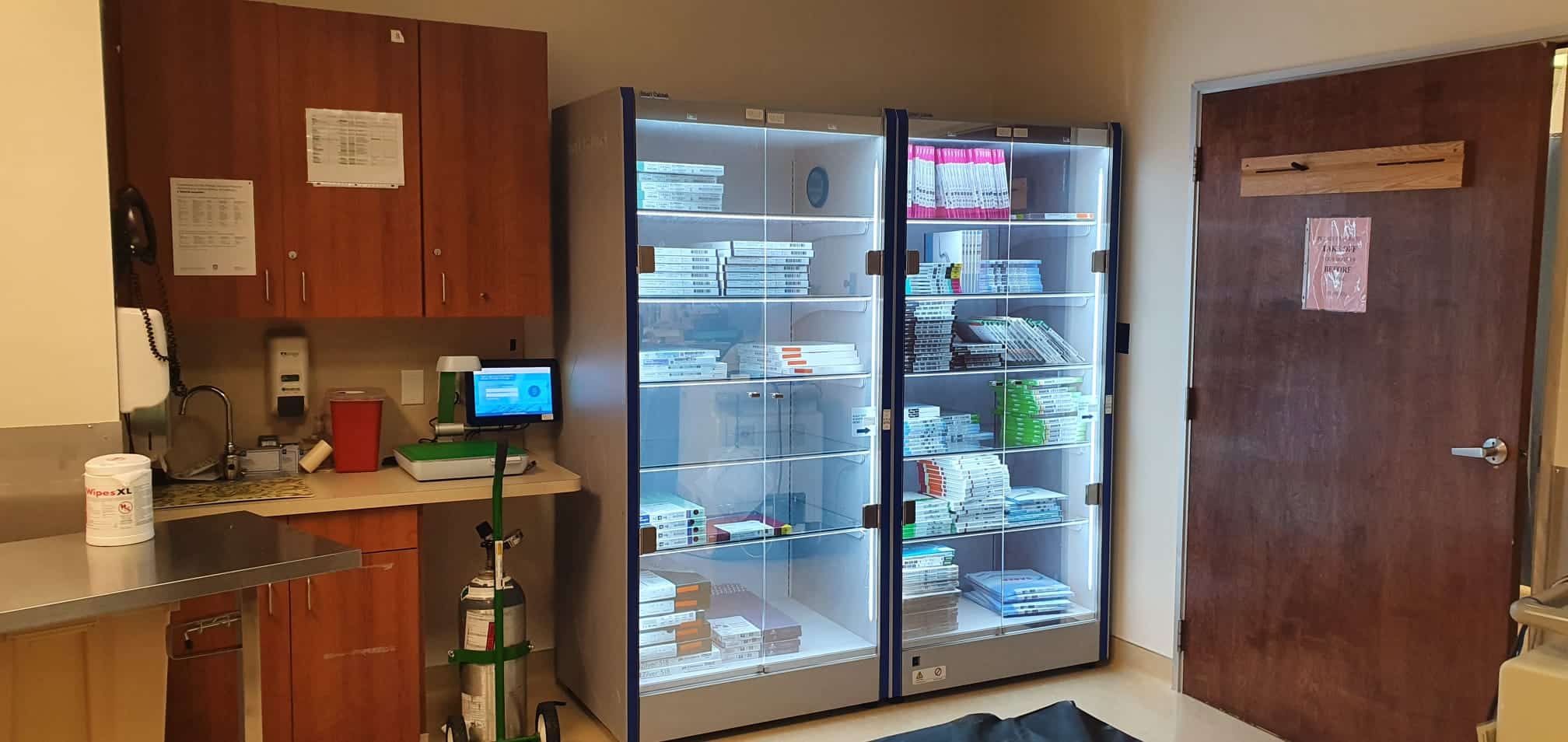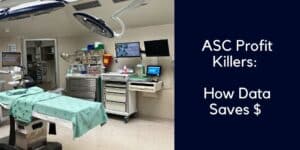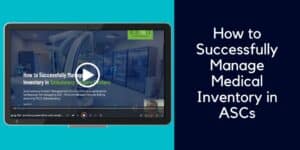What’s inside:
To improve their efficiency and competitiveness, ASCs are embracing new healthcare technology to:
- Streamline medical inventory and simplify supply chain workflows
- Improve medical inventory control. regulatory compliance and patient safety
- Reduce operational costs plus optimize revenue
- Produce data analytics to inform decision making
- Improve job satisfaction and retain staff
ASCs are embracing technology to improve their medical inventory management
The ambulatory surgery center sector is growing rapidly as patients seek more convenient and affordable outpatient procedures.
As the sector expands, ambulatory care providers are trying to strengthen their position amongst the growing competition. ASCs are looking to improve the efficiency and cost-effectiveness of their operations, understanding that there is a direct link between leaner operations and optimized performance. However, the ultimate goal is for high-quality patient care, so all business improvement initiatives need to support both operational and clinical performance.
Inventory management is a cross-organizational activity and a key area that ASCs need to get to grips with. It’s a high-cost resource that is time-intensive to manage and is known to be fraught with operational inefficiencies that can jeopardize successful reimbursement.
Operational efficiency is critical for any business, but it is especially important in the healthcare sector, because of the direct link to patient safety and quality of care.
In a competitive market, ASCs that leverage healthcare technology to streamline operations and reduce routine tasks will be best positioned to attract and retain patients.

Best practice for healthcare inventory management
There are many ways to improve ASC operational efficiency, especially since many ambulatory care providers currently use manual methods or outdated systems. There is currently a sector-wide push toward investing in technology that can streamline and automate workflows to aid operational and clinical performance.
Technology can significantly reduce the amount of time spent on routine tasks, decreasing the burden on staff who are already overstretched due to an ever-increasing workload, combined with a reduced workforce. Taking the pressure off busy members of staff has a positive impact across the whole team.
Surgical documentation is an example of a workflow that is broken in many ASCs. Current systems and tools, such as ineffective barcode scanners, commonly fail to capture full usage data and, in order to keep turnover times tight, nurses are often required to spend time outside of surgery entering all that missing data by hand.
Many ASCs struggle with point-of-use data capture. Current barcode and ERP limitations mean that many items being used in surgery do not have an up-to-date entry in the system or may not be listed at all. This reliance on the central Item Master limits the effectiveness of the entire workflow, making utilization documentation a longer task that often involves additional keying-in after the procedure has ended.
The right POU DATA CAPTURE TOOL can take the supply chain admin burden away from nurses, giving them a quick and simple way to document utilization to improve more important tasks.
Performance Improvement goes high tech
As we have said, perioperative usage data is notoriously difficult to collect, leading to manual workarounds when surgery is over. By using technology ASCs can add accuracy and efficiency to this task and make improvements to both clinical and operational performance.
- Clinical performance is improved by the nurse having more time to support the clinical team and focus on the needs of the patient without the distraction of complicated documentation.
- Operationally, the automation of manual administrative tasks improves the accuracy and completeness of utilization data. Once captured at the point of care, usage data is shared with other hospital systems which facilitate the movement of other workflows.
Running alongside performance, and a constant consideration, is the need for regulatory compliance such as the FDA’s UDI standards – any changes made to process need to support compliant practice. Not surprisingly the accuracy of implant tracking achieved by technical tools is far high then manual data entry and will provide an organizational safety net when it comes to compliant practice.
Technology can help point-of-care documentation
Technology can help automate workflows in the OR by digitalizing processes and paperwork through solutions such as automated point-of-use data capture. This means that, if the right tool is used, nurses and other staff can spend less time on data entry and more time caring for patients which is a direct driver for improved clinical outcomes and patient satisfaction.
Technology can help automate this process by providing a digital solution that can be used at the point of use. This means that all items being used in surgery are automatically entered into the ERP and EMR systems. While there are currently many tools on the market that endeavor to achieve this task, the reality is that they are unable to record full details of all items used in surgery. However, new computer vision technology is now here that documents every item at the point of care without the need for any additional manual data entry. This can save considerable time and improve accuracy, as well as reduce the administrative burden on nurses.
If ASCs make wise decisions on the correct tools to use then automated charting is possible which gives them 3 big wins:
- Improved patient safety
- Accuracy and complete usage and charge capture data
- Increased nurse time to focus on the patient

Reducing medical inventory wastage
Wastage is a significant issue for ASCs, but it doesn’t have to be. Technology can help reduce wastage by improving stock visibility and management.
One issue that ambulatory care centers are keen to address is the wastage of products that expire on the shelves before usage.
To prevent the expiry of medical implants and other items, many ASCs assign staff to undertake regular manual checks of products, in a bid to gain control of their stock. Some organizations assign two members of staff to this task every month.
It’s ironic – in an attempt to prevent one type of waste they inadvertently end up creating another, as staffing resources and costs get diverted to a task that would not be required if more efficient healthcare inventory management was in place.
The best way to prevent wastage is to have active and accurate stock control – and the easiest way to achieve this is by using technology.
Sophisticated RFID MEDICAL CABINETS can monitor stock in real-time and provide itemized reports on soon-to-expire items so that these can be prioritized for use before expiry.
Automated inventory control systems ensure staff can prioritize the usage of soonest to expire items, preventing items from expiring on the shelf.
Automated inventory management system
Medical inventory is one of the highest costs involved in healthcare delivery, so ASCs need to find effective ways to track inventory. Using technology to manage and monitor medical inventory removes the need for inventory counting and prevents the human errors which can lead to incorrect orders and wastage.
Automated inventory control prevents stockouts and surpluses, by ensuring accurate restocks. By doing so a streamlined inventory is achieved, wastage decreases, and supply chain costs are reduced.
Investing in automated inventory management ensures full stock visibility and control – the automation of many supply chain tasks adds speed, accuracy and efficiency – from ordering supplies to managing inventory, right through to item validation and usage documentation.
Point-of-use automation boosts patient safety
As we have outlined, automating tasks and streamlining workflows at the point of use can have a significant impact on patient safety.
Reducing error-prone manual data entry with accurate automation ensures full utilization documentation.
The right POU data capture tool can also provide pre consumption alerts on recall/expiry – this timely and crucial warning takes the pressure off busy nurses and gives them a pro-active last minute warning system that prevents ‘never events’.
Technology enhances patient safety by introducing important safeguards that protects patients.
Robust data leads to efficient recall management
Recalls are an unavoidable part of healthcare delivery, but they can be managed more efficiently with the help of technology. By automating usage documentation, ASCs can ensure that the EMR correctly reflects consumption and that in the case of a future recall, the patient is easily identified and contacted.
Using technology to track and manage patient usage data ensures that all the necessary information is readily available in the case of an unfortunate recall occurring. A speedy reaction to recalls minimizes risk and prevents ‘never events’.
Solid digital records support quick and efficient recall management.
The role of data in optimized surgical billing
Surgical billing is a critical workflow in healthcare delivery. To ensure accurate and complete medical billing and full reimbursement, the data that flows from surgical suites to the hospital’s billing system needs to be timely and accurate. Many ASCs are aware that their POU data is not robust and are having to put audit arrangements in place to capture missing data.
Point-of-use data-capture technology can help to optimize surgical billing by automating the full and accurate capture of usage data, ensuring an efficient billing process, submitting clean claims quickly, and avoiding payment delays.
Use of data analytics in reducing the cost of surgery
Capturing accurate consumption results in the collection of meaningful analytics that can support data-driven decision-making. ASC leaders will be looking to identify areas of inefficiency and variance so that they can apply best practices across the team.
In addition, data analytics can help ASCs to benchmark their performance against other facilities and identify opportunities for cost savings.
Effective quality improvement is based on accurate data that informs and drives management decisions.
Using healthcare technology to drive quality improvement
ASC quality improvement programs are enhanced by the right tools, for example, those that can help measure and track progress, identify areas for improvement, and ultimately make better patient care possible.
Healthcare organizations have long been using various types of quality improvement (QI) programs to great effect. But in recent years, the use of healthcare technology at the point of data capture has become increasingly prevalent. Gaining accurate data is key to achieving an effective QI program.
Once accurate data is analyzed it can provide the benchmarks and insights needed to design QI initiatives that have operational and clinical benefits.
Attracting nursing staff in the post-pandemic world
ASCs can find it hard to match the salaries and packages offered by larger hospitals and IDNs. With a reduced workforce available ASCs are having to find ways to both retain their existing nursing staff and attract new recruits.
One way to do this is to work on job satisfaction. Removing routine administration and freeing up nurses to focus on direct patient care is achievable. By removing a driver of dissatisfaction ASCs can improve job design, nurse motivation, and job satisfaction, all of which contribute towards a happy and retained workforce.
The business of healthcare
When it comes to the business of healthcare, technology can be a powerful tool to help ASCs achieve their goals. Using inventory management software can optimize an ASC’s bottom line, helping them to achieve greater control and leaner operations.
Improving performance is a critical priority for ambulatory surgery centers. By automating workflows, reducing unnecessary administration, and improving both staff and system efficiency, ASCs can simplify, expedite and add accuracy to their workflows.
Operational efficiency is critical for any business, but it is especially important in the healthcare sector. This is because patient safety and quality of care are always paramount considerations. When ASCs streamline their operations and reduce unnecessary administrative tasks, they free up nurses’ time so that they can focus on providing the best possible care for their patients.
Automation supports improved ASC healthcare delivery
Technology is vital for ASCs, it can help ambulatory surgery centers manage their medical inventory more effectively.
Operational efficiency is a critical concern for all ambulatory surgery centers. By automating workflows, reducing unnecessary administration, and improving efficiency, ASCs can improve their performance and provide an excellent patient experience. Technology can play a vital role in helping ASCs to achieve these goals.
Automation also supports accurate data collection, improved quality improvement initiatives and improved benchmarking against other ASCs to enable a more competitive approach.
There seem to be clear wins when it comes to adding automation to ASC medical inventory and supply chain workflows. The time to improve efficiency and performance is now, as ASCs gear up for an increasingly competitive sector. Streamlining operational performance and gaining better control of expensive medical inventory also supports improved clinical effectiveness and better patient care.
The ASCs that grow and establish themselves in the outpatient day surgery sector will run leaner, automated operations. Embracing technology and removing manual administration is the way forward and this automation will drive through efficiencies and cost savings plus provide the foundation for smarter, data-driven management of patient care.
ASCs are competing against big players who are better funded and more established. They need to turn their simpler structures and reduced bureaucracy into an advantage by making smart decisions on the introduction of new technology.

ASC-friendly tools for increased efficiency
IDENTI Medical understands the ASC sector as well as the common workflow frustrations experienced by perioperative staff.
Our ambulatory service solutions are designed for quick and easy use by clinicians while capturing valuable management data that will drive through efficiencies.
Total Sense uses advanced RFID technology for accurate and real-time implant tracking and automated restocks. These smart medical cabinets add speed and efficiency to implant management.
Snap & Go is the brand new way to identify and record items used in surgery. It just takes 3 seconds for each item to be documented in the ERP and EMR.
Together these two innovative tools are the dream bundle for ASCs looking to have end-to-end control of their high-value medical supplies.
Contact us to find out how IDENTI Medical can give your ASC the edge by using cutting edge technology.






